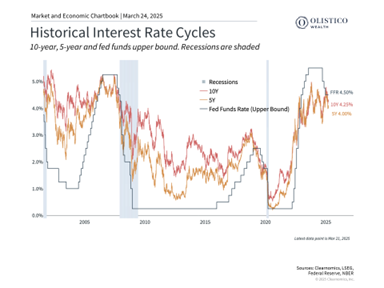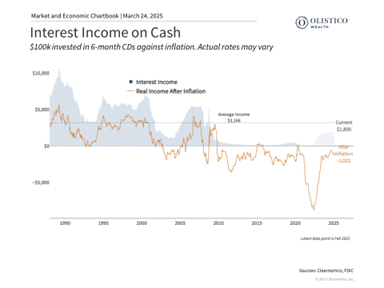In 2025, markets continue to be heavily influenced by Federal Reserve decisions. While the Fed implemented rate cuts in 2024 as inflation pressures diminished, it has maintained steady rates this year despite various economic concerns. Understanding the Fed’s current stance and its implications is crucial for investors navigating today’s market environment.
Current Fed policy reflects a wait-and-see approach.

The Federal Reserve’s congressional mandate focuses on two key objectives: maintaining price stability and maximizing employment. This dual mandate guided the Fed’s aggressive rate hikes in 2022 to combat inflation, followed by rate cuts in 2024 as price pressures moderated. Early 2024 fears of an economic slowdown from inflation-fighting measures ultimately proved unfounded.
Recent economic projections from the Fed’s March meeting indicate a potential slowdown, with 2025 GDP growth forecasted at 1.7%, down from 2024’s 2.5% according to the Bureau of Economic Analysis. The last sub-2% growth occurred in 2022 during peak inflation. Despite elevated inflation and unemployment expectations, the Fed has maintained its rate guidance.
The Fed’s balanced approach reflects several key considerations. Regarding tariffs, they distinguish between temporary price increases on specific items versus broader economic inflation. For example, 2018’s tariff-driven washing machine price spike eventually stabilized, unlike the widespread price increases seen during economic overheating or supply chain disruptions.
Current inflation measures remain above the Fed’s 2.0% target, contributing to recent market volatility. However, Fed Chair Jerome Powell emphasizes positive economic indicators including low unemployment, wage growth, and abundant job openings. He notes the frequent disconnect between consumer sentiment and actual spending patterns, with current retail sales remaining stable despite low consumer confidence.
The Fed also acknowledges data interpretation challenges. For instance, anticipated tariffs might initially increase consumer spending as people stock up before price increases. Additionally, while higher food prices impact consumers significantly, they are considered lagging indicators for inflation purposes.
Rate cuts remain likely despite current pause.

Looking ahead, both the Fed and market forecasts anticipate two to three rate cuts in 2025, suggesting confidence in continued inflation moderation despite tariff uncertainties. However, rate expectations can shift rapidly – early 2024 predictions of seven to eight cuts were later revised significantly.
The Fed has announced plans to slow its balance sheet reduction, effectively providing economic support through increased Treasury security purchases. This adjustment to quantitative tightening could impact interest rates independently of official rate decisions.
For long-term investors, the broader trajectory of monetary policy matters more than individual Fed decisions. Historically, declining rates have supported economic growth by reducing borrowing costs for businesses and consumers.
Managing cash positions in the current environment.

While elevated rates may make cash positions appealing, maintaining excessive cash can be detrimental to long-term financial goals. Markets often rebound unexpectedly, and missing these recoveries can significantly impact portfolio growth.
Despite attractive nominal yields, many cash investments currently offer negative real returns after accounting for inflation. The purchasing power of cash holdings can steadily erode even when account balances appear stable.
While higher-yielding cash vehicles exist, they typically don’t provide adequate long-term growth or income generation. Market uncertainty may persist due to recession concerns, tariff impacts, and Fed policy, but maintaining a long-term perspective remains crucial.
The bottom line? The Federal Reserve is maintaining a measured approach despite various economic pressures. Investors should similarly focus on long-term objectives rather than reacting to short-term developments. Staying invested through market cycles historically proves most effective for achieving financial goals.